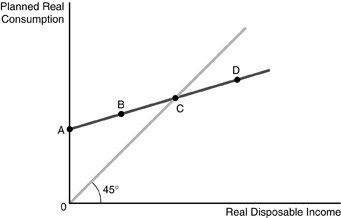A game in which one player's winnings equal the other player's losings is called a
A) tit-for-tat game.
B) all-or-nothing game.
C) fair-and-balanced game.
D) zero-sum game.
D
You might also like to view...
A demand schedule refers to the combinations of price and quantity that represent the:
A. Concerns of regulators. B. Preferences of businesses. C. Desires of consumers. D. Demands of producers.
 Refer to the above figure. The figure represents the consumption function for a consumer. Point A represents
Refer to the above figure. The figure represents the consumption function for a consumer. Point A represents
A. autonomous consumption. B. positive saving. C. negative consumption. D. zero saving.
Suppose the economy is initially at equilibrium, in which total planned real expenditures equals real GDP. Which of the following will occur if there is an increase in autonomous investment?
A. Inventories will not change and production of goods and services will not change either. B. Inventories will decrease immediately and production of goods and services will increase until real GDP catches up with total planned real expenditures. C. Both inventories and production of goods and services will increase. D. Inventories will increase immediately and production of goods and services will decrease until real GDP catches up with total planned real expenditures.
Keynesians believe that the difference between using an increase in the money supply compared with an increase in government spending to increase aggregate demand in the event of a recession is that if government spending is increased, ________ will be ________ than if the money supply is increased.
A. the price level; higher B. the price level; lower C. real interest rate; lower D. real interest rate; higher